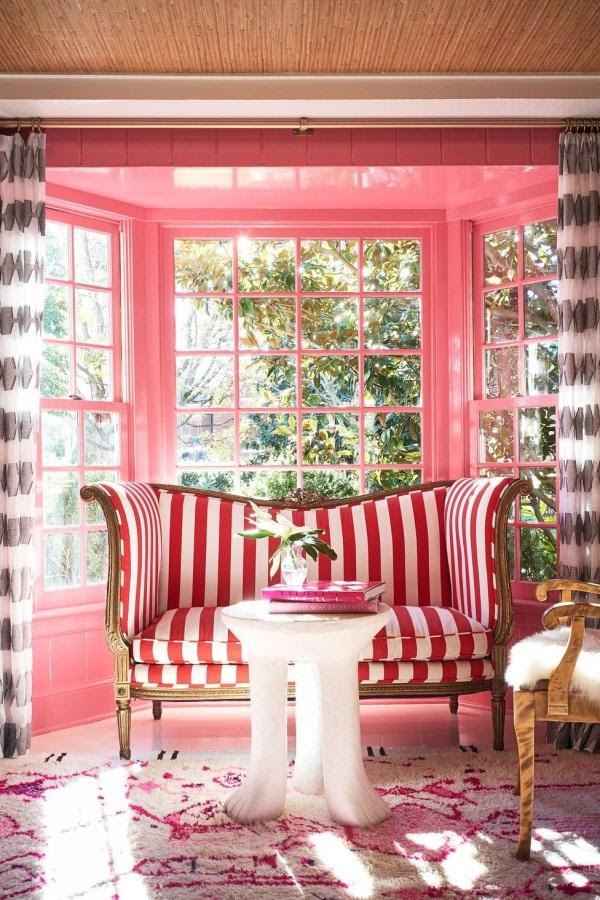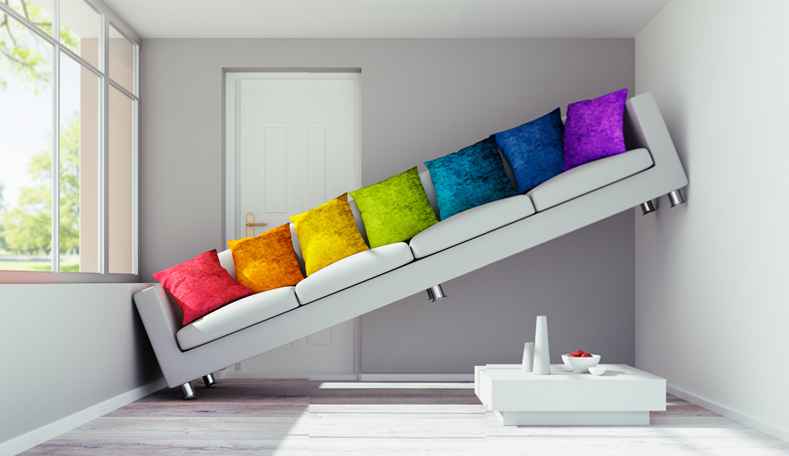If decorating your long and narrow living room feels challenging, our tips will help you turn it into an attractive, spacious room with just the essentials.
Choose colors wisely
Color affects how we feel and interact in a space. Using color wisely allows us to affect the way people perceive a room. Depending on the color, the intensity of it and the surrounding colors, a room can feel smaller or larger, taller or shorter, narrower or wider. In a narrow and long living room, soothing even tones have the ability to fool the eye into believing that there is more space. A good tip is to use the same colors for the walls and the furniture. This monochromatic color scheme has the effect of visually widening the room.
The colors of walls and furniture should be neutral and lighter hues. Light neutrals for walls can include warm whites, creams and light warm grays. Colors like these will make the walls recede, giving the feeling of more space. You can choose a light color for the sidewalls and paint the back wall in the same color range but two or three shades darker. This will make the sidewalls visually move away.

Neutral or pastel colors have an air of luxury due to the sophisticated pairing of similar tones. When decorating a long living room, consider light colors to create a sense of calm and serenity. Light tones, pastels, and neutrals will help you achieve a more spacious feel. If you want to add a touch of bold color to your living room, apply it on a single wall, in accessories or textiles. By placing colorful furniture and accessories, the eye is drawn to specific points in the room, allowing you to direct the eye to a desired focal point and adding personality. If your living room does not get a lot of light, avoid using darker colors. Dark colors absorb light and can make a room feel smaller.

Choose the focal point
Think about where you are going to place the most eye-catching decorative elements. If you place an elegant drapery at the narrow end of the room, you will draw attention to that area, highlighting the tunnel effect. Conversely, if you place an eye-catching rug in the center of the room or an attractive lamp in a strategic spot, you will focus your attention there.

Less is more!
The most important thing to keep in mind for living rooms with limitations in shape or size is to choose a minimalist decor so as to avoid clutter.
Pick sofas that have little depth and narrow armrests, along with armless chairs, since they take up less space. A shelf, or a table with drawers, is a better choice than several side tables. Try nesting tables; they take up very little space, and can be moved around the room when needed. Using glass tables gives the illusion of more space, their transparency, makes them visually disappear.

Many times we try to fit too much furniture into a small space. Avoid it as far as possible. Consider pieces that can fulfill several functions. Choose pieces with storage built in, they are versatile and are multifunctional. An ottoman with storage inside reduces clutter, and can be used as extra seating, when the need arises. Similarly, a shelf with drawers provides additional storage, while small tables with wheels allow you to move them easily to where they are needed. Sofas that have storage inside will help you to keep the living room organized. When space is an issue, you must be pragmatic and reasonable. Even if you like that four-seater sofa, and large coffee table, or the trendy armchairs, this is where being practical is important. Be aware of the numerous possibilities available to you in furniture, and adapt your decor to the space you have. Another good tip is to avoid overcrowding the room with furniture and accessories. In rooms such as these, clutter is the enemy.
Where should the sofa go?
In large rooms designers will place the sofa away from the wall to create an intimate seating group encouraging conversation and interaction. In long and narrow rooms, the reverse is needed. A standard sofa is best placed against a wall, allowing for ease of movement through the room.
Sectional sofas are an excellent option. They often have a movable piece that can be placed somewhere else according to your needs. You can even remove it if it takes up too much space.
Sleeper sofas offer a lot of flexibility, especially when there is an occasional guest. An L-shaped sofa for your long living room is an excellent decision since it is a versatile piece that allows you to create a seating area without additional chairs

Another option for shortening the room is to place the sofa along the wall at a midpoint in the room. This creates a seating group that provides a focal point which visually shortens the room.

If you need to include a dining area in your long and narrow living room, it is essential not to lose the feeling of spaciousness. One option is to place the dining area next to the entrance of natural light, parallel to the windows or balconies.

Mirrors work magic
Mirrors are a great way to add personality and dimension to any decor. Mirrors do double duty – they reflect light and can also make a space seem larger and more open. They come in a variety of sizes, shapes, colors, and styles, and help to reflect views while adding interest.
Placement and location are key when using mirrors. In long and narrow rooms, adding mirrors to a wall opposite a window or glass door extends the view, creating the illusion of another window. This takes advantage of the reflective value creating an illusionary effect which widens the room visually, and brings light into the space. Adding mirrors to the back of bookcases, built-in units will add depth and help to make the room seem larger. You can use a single large mirror or a group of smaller ones to get the desired effect.

Think vertically
Maximize your storage by going vertical. Floor to ceiling built-in units and bookcases provide great storage options. A combination of open and closed shelving helps to control clutter and provide display space for collections, books or objet d’ art. Mounting the TV on the wall opposite the sofa will free up floor space, making the room look and feel more spacious.
Decorating a long and narrow living room does not have to be a daunting prospect. By applying some of the design tips above, you, can enjoy your new space while gaining a sense of spaciousness and comfort.

Hi, I'm Kathy!
I am an expert color consultant with over 30 years of experience in interior and fashion design. I help both residential and commercial clients create unique looks for their homes and businesses.
Clients often come to me seeking sharp attention to detail, reliable work, and an excellent sense of design--all of which I pride myself on delivering.







